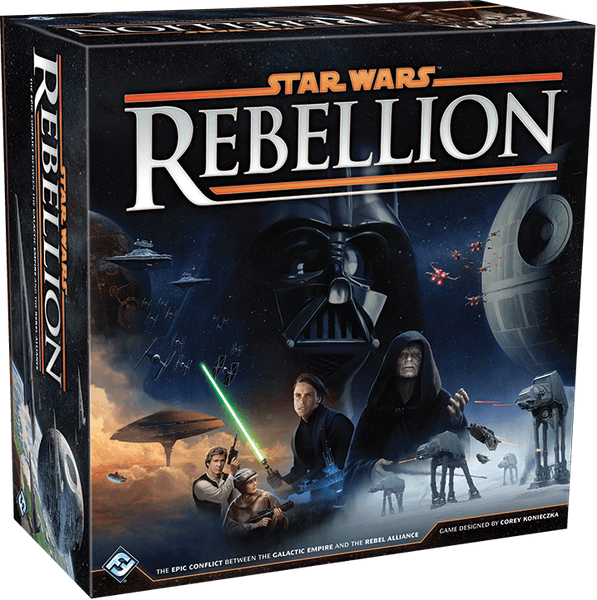With the pandemic limiting in-person gaming, I’ve had my eye on good two-player games for me and Joy for a while, and Star Wars Rebellion finally popped up as a buy. From Fantasy Flight Games (FFG), Rebellion lets 2-4 players play out the early days of the Rebellion against the Galactic Empire. As is thematically appropriate, the play is highly asymmetrical. The Imperial player is trying to locate and destroy the hidden Rebel base, while the Rebels are trying to build sympathy for their cause before the Empire strikes (back?). While the game is technically 2-4 players, it’s really a two player game with the ability to divide the work between two players on each side (a General and an Admiral).

The table presence of this game is amazing – miniature Imperial and Rebel units zip from planet to planet, while leaders deploy to systems to attack or fulfill missions. About the only complaint I have with the components is that miniatures for the leaders would have been cooler, but the cardboard standees do contain a lot of information that would have had to be on cards otherwise, so it’s a small gripe.
Each turn, players assign some of their leaders to complete missions by placing them on face-down mission cards. Some missions are standard and can be completed multiple times, like building support for the Rebellion through diplomacy or sending out probe droids, but most missions are one-shots. Once the missions are selected, the Rebel player goes first to activate a leader. The activated leader could be one assigned to a mission, or could be placed in a system to move units there. One unique aspect of the movement is that when placing a leader in a system, units can move from ANY adjacent system, allowing assembly of massive combined forces. Another is that ground units must be transported – if you don’t have enough transport capacity, you’ll have to leave some behind. Consistent with Star Wars lore, TIE fighters (with no hyperdrives) also require transport.
Activating a mission also requires placing the leader or leaders on the card in the appropriate system, and here is where the interaction starts to happen. The opposing player can use an uncommitted leader to try to oppose the mission. If there’s no opposition, the leader automatically succeeds if they have the right skills for the mission. If there is, the two players roll dice based on the number of appropriate skill icons for the leaders carrying out and opposing the mission (shown on their standees). This makes for some challenging strategic decisions – how many leaders do you commit to missions, versus keeping them available to counter your opponent or move your forces?
Many of the rebel missions increase their influence in the galaxy, and this moves a counter down on the turn track. If the turn marker reaches the influence counter before the Rebel base is destroyed, the rebels win. Missions can also add more leaders or, in the case of the Rebels, sabotage production capacity. Imperial missions can capture Rebel leaders – and the Rebels can use missions for daring rescues. Imperial missions also often involve massive projects like activating the Death Star superlaser, building Death Star 2, or constructing Super Star Destroyers.
If the Imperials and Rebels meet in a system, combat ensues. The combat system is moderately complex, but essentially it involves rolling dice based on the type of units you have in the system and inflicting damage based on the rolls. Tactics cards can modify these results, and your leaders in the system determine how many you start with. Ground and space combat are handled separately. At the end of each round of both, and barring any special tactics cards, either force can retreat – if they have the transport capacity to do it.
Joy and I had a ton of fun playing this. It’s NOT a short game – we played it over a few days, a couple of hours at a time. Although we were both novices, it came down to the wire, with the Rebels needing only one turn when the Empire reached the Rebel base on Tatooine and wiped it out. For any Star Wars fan up for a fairly complex, long-form game, I’d highly recommend it.


Leave a Reply